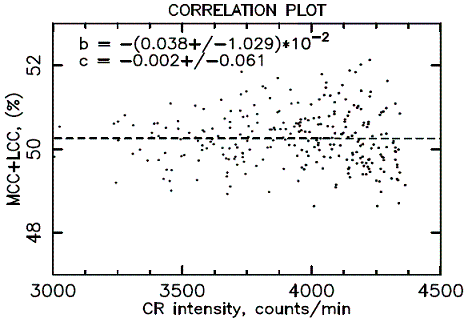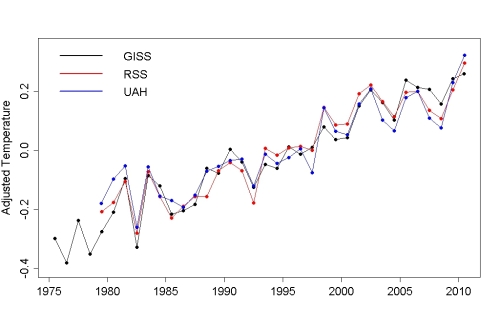Cosmic ray contribution to global warming negligible
Posted on 24 April 2011 by Ari Jokimäki
There have been claims that cosmic rays could have contributed significantly to the global warming over the past century. According to a new study, that is not the case. Instead, during the last 50 years, cosmic rays seemed to have caused warming of only about 0.002°C - a negligible amount compared to observed warming.
Figure 1. Correlation of cosmic ray flux with low and medium cloud cover.
Cosmic rays have been claimed to be a significant source for the formation of cloud condensation nuclei, and through that mechanism they have been claimed to affect Earth's climate significantly. There have been many studies debunking these claims, and currently it seems that the possible effect of cosmic rays on the climate is small (see Skeptical Science advanced rebuttal to cosmic ray hypothesis). It is however likely that there are some mechanisms by which cosmic rays do affect cloud formation at least a little. For example, recently a correlation was found in Europe between diurnal temperature range (difference between daily maximum and minimum temperatures) and strong cosmic ray flux changes (Forbush decreases and ground level enhancements).
A new study by Erlykin et al. evaluates the effects of cosmic rays to cloud cover. The paper discusses previous cosmic ray research, and performs some new analysis. They use cloud cover measurements of International Satellite Cloud Climatology Project (ISCCP). There have been criticisms of ISCCP data, but the researchers believe that ISCCP problems do not affect their results.
Evidence of cosmic ray effects
Solar activity changes during the sunspot cycle and effects Earth's temperature. According to Erlykin et al., the change in temperature then effects the height of low clouds. The change of height makes some of the low clouds migrate to the medium cloud region. This would then cause a decrease in the amount of low clouds. This would also be a candidate for the origin of the correlation between cosmic ray flux and low cloud cover (because solar activity changes are known to affect also cosmic ray flux). When analysing cloud cover changes it would make sense to look at the changes in both the low and medium clouds. When both low and medium clouds are included to the correlation analysis, the correlation with cosmic ray flux is poor.
Forbush decreases (few percent decrease in cosmic ray flux that lasts few days) have been claimed to cause cloud cover changes. However, the observed correlations between cloud cover changes and cosmic ray flux during a few Forbush decreases could have been coincidental. Additionally, delay between the changes in cosmic ray flux and in cloud cover seems to have been too long for the two to be causally related. Some of the strongest Forbush decreases have also been associated with strong changes in solar activity, which further clouds the cosmic ray warming hypothesis.
Nevertheless, there is some evidence relating to Forbush decreases that suggests some kind of effect on cloud cover. The strongest effect seems to lie in the stratosphere, but there is also some evidence for an effect in troposphere. It is unclear if these effects are due to cosmic rays or solar activity.
For cosmic ray flux ground level enhancements there also is some evidence of cloud effects. The strongest effect seems to occur in the poles which might suggest genuine cosmic ray involvement. Erlykin et al. estimate a global effect of about 1% in cloud cover during ground level enhancements.
In a recent analysis, it was found out that in mid-latitudes rapid changes in cloud cover are associated with changes in cosmic ray flux and in surface temperature. Strong reaction here only occurs during the rapid cloud cover changes, which are rare events, so the total effect of cosmic rays still seems to be small. Here too it is unclear if the observed effects are due to cosmic rays or simultaneous changes in solar activity.
In the case of these rapid changes, the rates of change in clouds and in cosmic rays have been different, which speaks against the cosmic ray origin. On the other hand, linking these cloud changes to solar activity is also problematic, because most of the UV radiation stops in the stratosphere, and therefore would not be able to cause changes to most of the cloud cover. It is possible that the explanation for cloud changes is found in surface temperature changes caused by solar activity changes.
There is lot of evidence from polar regions on stratospheric cosmic ray effects, which usually are related to solar flares. It seems that cosmic rays have an effect on stratospheric aerosols, ozone, wind, temperature, pressure and ionisation. There is also some evidence of possible effect on stratospheric clouds during Forbush decreases and other cosmic ray flux changes, but the size of the possible effect is unclear.
Correlation between cosmic ray flux and cloud cover
Analysis of cloud cover correlation between cosmic rays and UV radiation reveals that correlation is significant only in these cases: low cloud cover with cosmic rays (positive correlation) and with UV radiation (negative), medium cloud cover with UV radiation (positive), and high cloud cover with cosmic rays (negative). For the case of UV radiation, the different sign for the correlation with low and medium cloud cover might be explainable by part of low cloud cover changing to medium cloud cover when surface temperature changes. For cosmic rays, the negative correlation with high cloud cover is not what would be expected from ionization mechanism.
The correlation of cosmic rays with low cloud cover is the correlation that has been claimed to cause the global warming. However, the spatial distribution of the correlation does not fit to the expectations from cosmic ray origin. Correlation is strong in mid-latitudes, but weak in the poles and in the equator. Mid-latitude correlation is about 8 times higher than the correlation in equator and in poles. This distribution of correlation results a possible effect to global cloud cover which is smaller than 1%.
According to Erlykin et al., the cosmic ray flux has decreased about 0.6% in last 50 years. Assuming 1% effect of the cosmic rays to cloud cover, this would cause a warming of 0.002°C in global surface temperature. This is negligible compared to the observed global warming in last 50 years.
In conclusion, while cosmic rays do seem to have some minor atmospheric effects, they do not seem to have anything to do with global warming, particularly over the past century.
Source: A.D. Erlykin, B.A. Laken and A.W. Wolfendale, Cosmic ray effects on cloud cover and their relevance to climate change, Journal of Atmospheric and Solar-Terrestrial Physics, doi:10.1016/j.jastp.2011.03.001. [abstract]































 Arguments
Arguments























 0
0  0
0 I think it's quite a striking image, and it illustrates the amplitude limitations of this possible cosmic ray influence.
I think it's quite a striking image, and it illustrates the amplitude limitations of this possible cosmic ray influence.
 To summarize (with apologies to Sondheim),
And where are the clouds?
There ought to be clouds.
Well, maybe next year.
To summarize (with apologies to Sondheim),
And where are the clouds?
There ought to be clouds.
Well, maybe next year.







Comments